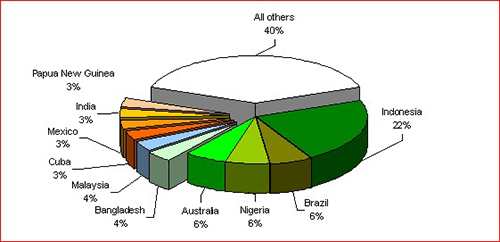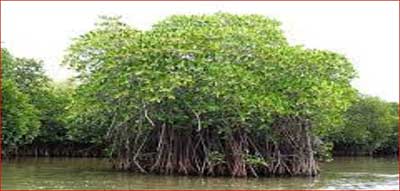Date: 12/11/2022
Relevance: GS-3: Biodiversity, Environment, Security and Disaster Management
Key Phrases: Mangrove Alliance for Climate, Conference of Parties, Mangrove Alliance for Climate, carbon sink, diverse marine life, Shrimp Farming, Charcoal and Lumber Industries.
Context:
- At the 27th Session of Conference of Parties (COP27), this year’s UN climate summit, the Mangrove Alliance for Climate (MAC) was launched with India as a partner.
Key Highlights:
- The Mangrove Alliance for Climate seeks to educate and spread awareness worldwide on the role of mangroves in curbing global warming and its potential as a solution for climate change.
- The move, in line with India’s goal to increase its carbon sink, will see New Delhi collaborating with Sri Lanka, Indonesia and other countries to preserve and restore the mangrove forests in the region.
- India is home to one of the largest remaining areas of mangroves in the world, the Sundarbans and has years of expertise in restoration of mangrove cover that can be used to aid global measures in this direction.

About Mangroves:
- A mangrove is a shrub or tree that grows in coastal saline or brackish water.
- The term is also used for tropical coastal vegetation consisting of such species.
- Mangroves are taxonomically diverse, as a result of convergent evolution in several plant families.
- They occur worldwide in the tropics and subtropics and even some temperate coastal areas, mainly between latitudes 30° N and 30° S, with the greatest mangrove area within 5° of the equator.
- The oldest known fossils of mangrove palm date to 75 million years ago.
- All of these trees grow in areas with low-oxygen soil, where slow-moving waters allow fine sediments to accumulate.
- Mangrove forests only grow at tropical and subtropical latitudes near the equator because they cannot withstand freezing temperatures.
- Many mangrove forests can be recognized by their dense tangle of prop roots that make the trees appear to be standing on stilts above the water.
- This tangle of roots allows the trees to handle the daily rise and fall of tides, which means that most mangroves get flooded at least twice per day.
- The roots also slow the movement of tidal waters, causing sediments to settle out of the water and build up the muddy bottom.
The Mangrove Alliance for Climate:
- An initiative led by the United Arab Emirates (UAE) and Indonesia, the Mangrove Alliance for Climate (MAC) includes India, Sri Lanka, Australia, Japan, and Spain.
- It seeks to educate and spread awareness worldwide on the role of mangroves in curbing global warming and its potential as a solution for climate change.
- It will go a long way in driving collective climate action and rehabilitating blue carbon ecosystems.
- However, the intergovernmental alliance works on a voluntary basis which means that there are no real checks and balances to hold members accountable.
- Instead, the parties will decide their own commitments and deadlines regarding planting and restoring mangroves.
- The members will also share expertise and support each other in researching, managing and protecting coastal areas.

The significance of mangroves:
- Host diverse marine life : Mangrove forests — consisting of trees and shrubs that live in intertidal water in coastal areas — host diverse marine life.
- Support a rich food web : They also support a rich food web, with molluscs and algae-filled substrate acting as a breeding ground for small fish, mud crabs and shrimps, thus providing a livelihood to local artisanal fishers.
- Act as effective carbon stores: Equally importantly, they act
as effective carbon stores, holding up to four times the amount of
carbon as other forested ecosystems.
- Mangrove forests capture vast amounts of carbon dioxide from the atmosphere and their preservation can both aid in removal of carbon from the atmosphere and prevent the release of the same upon their destruction.
- Stabilize the coastline: Mangrove forests stabilize the coastline, reducing erosion from storm surges, currents, waves, and tides.
- Attractive to fish and other organisms: The intricate root system of mangroves also makes these forests attractive to fish and other organisms seeking food and shelter from predators.
The current state of the mangroves:
- South Asia houses some of the most extensive areas of mangroves globally, while Indonesia hosts one-fifth of the overall amount.
- India holds around 3 percent of South Asia’s mangrove population. Besides the Sundarbans in West Bengal, the Andamans region, the Kachchh and Jamnagar areas in Gujarat too have substantial mangrove cover.
- However, infrastructure projects - industrial expansion and building of roads and railways, and natural processes - shifting coastlines, coastal erosion and storms, have resulted in a significant decrease in mangrove habitats.
- Between 2010 and 2020, around 600 sq km of mangroves were lost of which more than 62% was due to direct human impacts.
Various Threats to Mangroves:
- Shrimp Farming
- By far the greatest threat to the world's mangrove forests is the rapidly expanding shrimp aquaculture industry.
- Hundreds of thousands of acres of lush wetlands have been cleared to make room for artificial ponds that are densely stocked with shrimp.
- Tourism
- Tourism is a booming industry and an important source of income in many developing nations.
- Unfortunately, irresponsible tourism can destroy the very resources people are coming to see.
- Agriculture
- Many thousands of acres of mangrove forest have been destroyed to make way for rice paddies, rubber trees, palm oil plantations, and other forms of agriculture.
- Farmers often use fertilizers and chemicals, and runoff containing these pollutants makes its way into water supplies.
- Charcoal and Lumber Industries
- Chopping down mangroves for charcoal and timber is an important cottage industry for many coastal communities.
- Mangrove wood is used for building material, fencing, and fuel.
Conclusion:
- More and more people around the world are organizing to protect and restore these ecologically, biologically, and culturally diverse coastal forests.
- Communities around the world are learning how to protect mangroves and use them in sustainable ways for a better future.
Source: Indian Express
Mains Question:
Q. What is a Mangrove? Discuss its ecological significance keeping in view about the current state of Mangroves. (250 Words).








